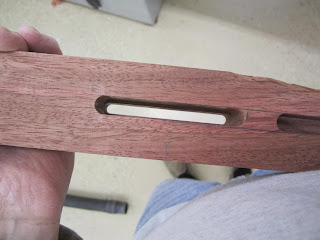Back to wood. In preparation to the first major glue-up there are a few things to do. First thing is to trim the rear posts. I cut the bottom of the post about a 1/4" below the rear rail. I simply use a crosscut saw and then I hand plane an 1/8" bevel all around the bottom post. For the top, I clamp the seat area well then I mark the distance up on both posts. Next I run a straight edge across to knive out the location.
I knife around the entire post. Now, I'm not that good with the hand saw to cut exactly to the line. Consequently, my game plan is to saw close and then use the shoulder plane to take me to my knife line. I've done this with cherry and mahogany. So I leave a heavy 1/64". Well, after a few passes with the shoulder plane (even with a freshly sharpened blade), I realize planing bubinga end grain ain't all what it's cracked up to be. So I decide that I will use a router jig later to even the top.
I'm using a floating tenon to connect the rear post to the crest rail. I will cut the mortise in the top of the post before glue-up:
The next thing I need to do is touch up the side rails. Because the rear posts have a cant angle the side rails meet the rear posts somewhat caddy wampus:
I need to hand plane a wind in the side rail so it meets the rear post with an even reveal. I determine how much I need to remove and mark out the bottom of the rail:
Now I start planing a wind in the side rail. I then sand the piece to 180 grit to smooth out the transition of the wind. If you plane well, it has an Escher quality about the look - the front is straight up and down while the rear post has a cant - yet the rail appears flat.
So, I sand everything to 180, careful not to sand the joinery areas (we want those areas flat - they were hand planed earlier so no prep sanding is required here). Next I make some wedges for the through tenons:
Glue up! First I glue the posts to the rear rail:
Next I glue the side rails to the rear posts. This requires some angled cauls to counter the splay angle of the side rails and give the clamps a 90 degree surface at both ends - and the cauls need to navigate the box joint fingers up front and the through tenons in the back.
To drive the wedges in, I had to clamp everything down and get things tight, then I briefly removed the clamp to drive in the wedges after which I re-applied the clamps. Oh yes, I did one rail at a time. I did not try to glue both rails at the same time.
The front rail required some head scratching and some series clamp yoga:
The cauls up front had to navigate the protruding fingers as well. For glue ups I generally remove the glue immediately and wipe down repeatedly and vigorously with damp cloths and a toothbrush to get into the grain. Whew! Glue-ups are always somewhat tense. After everything has dried I cut the through tenons down with a small flush trimming saw leaving them a bit proud. I'll round over the tenons later with sandpaper.
Now I'll go ahead and work on the seat innards. The swivel assembly will attach to the seat via two 1"x3" rails. These two rails will be glued and screwed to the underside of the front and rear seat cleats. The front and rear seat cleats are also 1" thick and glued and screwed to the rails. In fact, all the cleats are glued on eliminating the need for rabbets into the rails.
Before gluing the two 1" swivel rails I need to drill holes for where the swivel hardware attaches to these rails. I first make a drilling template with some 1/4" hardboard to define exactly where those holes need to go. I dry fit the swivel rails in the seat and mark out the hole locations with a 5/16" drill bit. Then I take the rails to the drill press to drill the 5/16" holes. Then I glue and screw those rails on. Those rails add a tremendous amount of strength and rigidity to the seat.
This pile of wood is finally starting to resemble a chair! Progress seems to come in leaps. I work for awhile (and sometimes a long time!) on various details but not feeling like I'm accomplishing a whole lot when suddenly, wham, the project takes a leap forward.
Ok, back to the rear posts. I need to level out the tops with a router (since I wimped out with my hand tools). I made this jig to help:
This jig worked extremely well! I'm using the ruler in the photo above to line up with my previous knife marks. I'm taking very little off here, just skimming the surface. I then made some maple floating tenons with the bandsaw and small Jet 10-20 drum sander:
Good time to call it quits here. The next blog will be about the crest rail and the back - a lot of work still ahead before the next major leap forward.























































